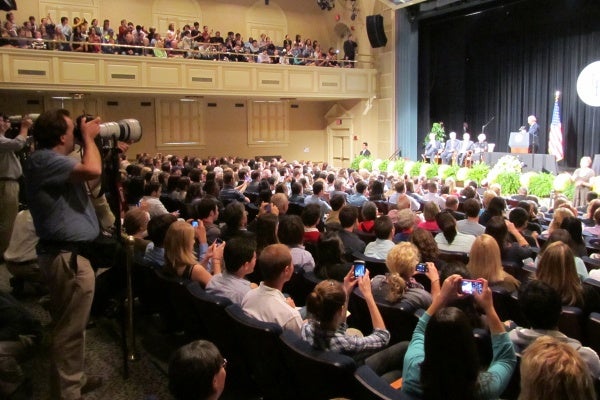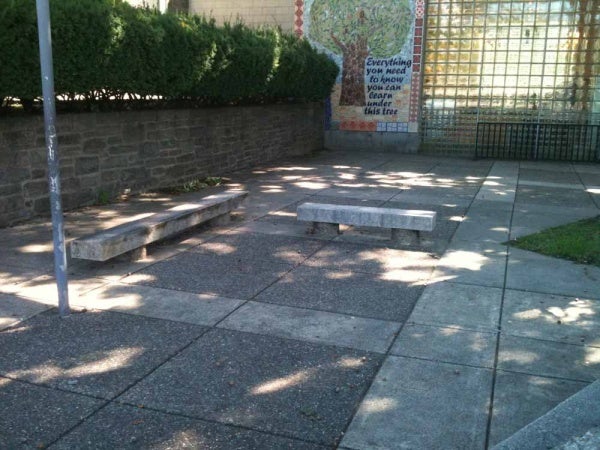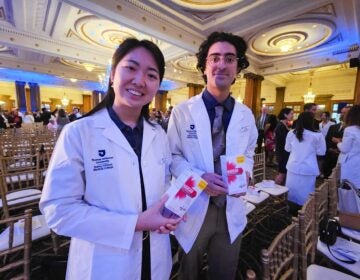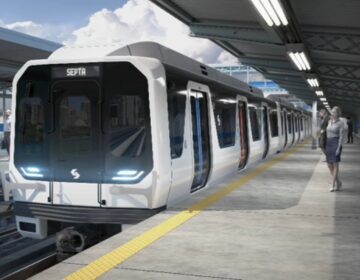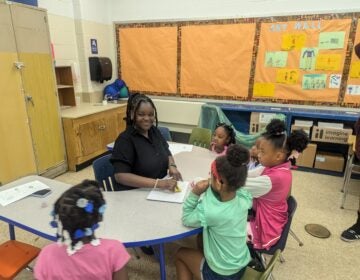Could Lovett Park become a ‘destination space’?
The grounds of the park next to Lovett Library on Germantown Avenue are an underutilized community asset in the view of Mt. Airy USA (MAUSA) Executive Director Anuj Gupta. The CDC thinks that the vest-pocket park, scarcely used during the day, has real potential for becoming an asset for the neighborhood in a variety of ways.
Planners from the Community Design Collaborative, under the sponsorship of MAUSA, have been studying the park’s potential and, on Thursday evening, presented what they were careful to call “only an undefined state of what could happen here” to an engaged audience of 25 to 30 community members at the library. The meeting was the second in a series designed to sound out possibilities for the park and get feedback and input from community residents.
Gupta said that he began thinking of how the space’s use might be energized while walking past it down the Avenue last fall en route to a political rally in Germantown.
“It was a beautiful fall day, the weather was perfect, and nobody was in the park,” he said. MAUSA’s Avenue Project to beautify and revitalize Germantown the Avenue was already in full swing; the park sits in the middle of the target area along the Avenue.
A brief overview of the history of the park and the library (privately founded in 1887 by the Lovett family and not part of the Free Library system until 1924) was given by Ari Miller of the Community Design Collaborative and David Moore, past president of the Friends of Lovett Library and an expert in local history. Ashton Jones of the Community Design Collaborative then gave a look at some of the thinking behind the planners’ work.
“Planners use the ‘five-minute walk’ concept a lot,” he said. “That’s about 1,500 feet. It’s generally what the distance is that people will walk to get to their destination. The task here is to turn this into a location that would be worth a walk.” The park is about 1,000 feet from the middle of the Mt. Airy business district, he said.
Ideas of transformation
Miller then began a graphic presentation of potential enhancements the planners had devised to make the grounds a more active space.
Their ideas included:
More seating and benches in the main lawn.
A small, 45-foot, diameter in-ground amphitheater next to the library for performances
A multi-purpose plaza with benches and chairs at the northwest rear of the grounds that could be used for events such as art shows and a farmer’s market.
A nature play area.
An enlarged outdoor reading area with the current sculptural benches relocated to it.
A rain garden that would minimize stormwater runof.
A enhancement of the corner area at Germantown Avenue and Sedgwick Street that would house the historical marker that currently is at the entrance to the park.
If all of these ideas were enacted, they would make for a complete transformation of the site, which including the library itself, totals slightly more than an acre and includes historic artifacts such as a horse trough along the Avenue and 15th century Turkish catapult balls (brought back in the 19th century by a U.S. Navy captain who was a relative of the Lovett family) on the pillars at the park entrance.
But again Miller emphasized, “This is not a plan, this is getting ideas from you, the community.”
And the planners got quite a few from the audience.
Addressing demand and safety
More than one observed that the ideas presented seemed to be putting the cart before the horse, with a more logical approach being to first schedule more events in the park and build up a base of use and experience before making any major changes.
Other observations included the need to think about security for the area. ‘What about the negatives that increased participation will bring,” asked Stephen Clark, who has been a security guard at Lovett for about six weeks. “I’ve already found several ‘instruments of crime’ while patrolling the grounds,” he said.
Potentially reduced visibility of the space from the Avenue was also a concern. Moore noted that there had been a problem some time ago when shrubbery had grown high inside the stone wall that encircles the grounds. They blocked the view from the Avenue, he said, and “local winos used to duck behind them to relieve themselves. They couldn’t be seen from Germantown Avenue but the patrons inside the library got a look at them emptying their bladders.” The bushes had to be removed.
Finding a plan that bolsters the site
Gupta made another observation regarding increasing the facilities and usage of the grounds, referring obliquely to Mayor Nutter’s scuttled plan to close some city libraries in 2009 during the onset of the city’s current budget crunch.
“A site enhancement somehow needs to bolster the library itself,” he said. “This city was built for 2.5 million people. We currently have 1.5 million living here. The budget debate is not going away. A stronger library will be better able to withstand pressures to close.”
Gupta said after the close of the meeting that the next meeting would be in “a couple of months” and the planning team will incorporate what they heard and come up with an actual plan to present to community stakeholders.
Any plan would require the approval of the Free Library as well, and money would then have to be raised to make any enhancements a reality.
“It’ll be a long process,” he said.
WHYY is your source for fact-based, in-depth journalism and information. As a nonprofit organization, we rely on financial support from readers like you. Please give today.




